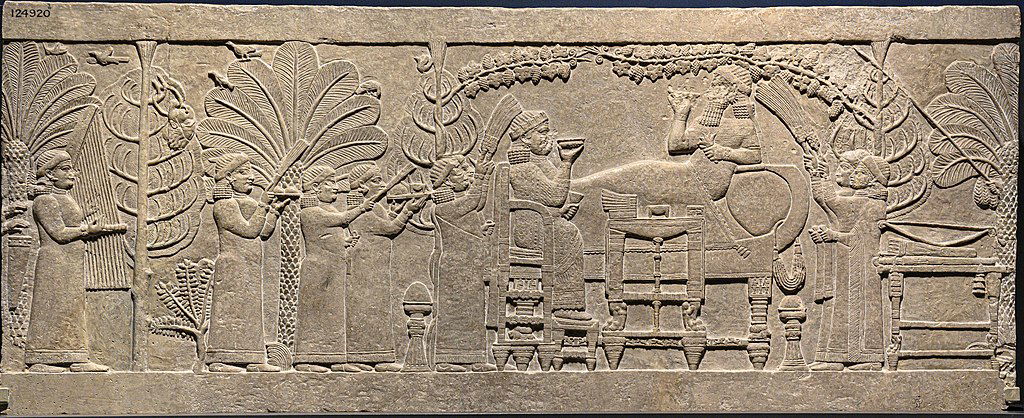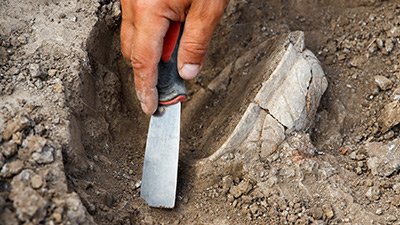
Have We Been Looking for This Historical Wonder in the Wrong Place?
The Hanging Gardens of Assyria?
When one thinks of the Seven Wonders of the Ancient World, the first to come to mind is often the Great Pyramids on the Giza plateau—with the largest, The Great Pyramid of Cheops (or Khufu), being one of those wonders. As it is the only extant of the seven, that is quite fitting. All the rest of the wonders (the Colossus of Rhodes, the Lighthouse of Alexandria, the Mausoleum at Halicarnassus, the Temple of Artemis, the Statue of Zeus at Olympia, and the Hanging Gardens of Babylon) have been destroyed, most by earthquakes.
The interwoven history of Assyria and Baylon over the time period of c. 2000 BC to 605 BC is a complicated one. Sometimes Babylon controlled Assyria as a vassal state, and other times, it was Assyria in control of Babylon.
The Conflated History of Babylon and Assyria
Shalmaneser I, king of Assyria (according to standard chronology, reigned 1274–1245 BC), after defeating the Mitanni and the Hittites in battle (1273 BC) declared that Assyria was no longer a vassal of Babylon and claimed supremacy over western Asia. He fought the Hittites in Anatolia and established more colonies in Cappadocia (Turkey). His son Tukulti-Ninurta I (reigned 1243–1207 BC) finished his father’s conquest of the Hittites and then conquered Babylon (c.1214 BC) by taking the Babylonian king Kashtiliash IV captive, which made Assyria the dominant power in Mesopotamia.
However, Babylon did not stay under Assyria’s yoke long but rebelled and became independent again in seven years under Assyrian king Ashur-nadin-apli. For some time, both nations coexisted as equals, with monarchs occasionally visiting each other’s royal cities. But a few hundred years later Babylon was conquered again in 911 BC by Assyrian king Adad-nirari III (likely the monarch mentioned in Jonah 3:6–10). Babylon again revolted and became independent, but 60 years later, Babylon was again conquered by the Assyrian king Shalmaneser III in 851 BC and remained a vassal state for two more centuries.
Of course, it was Babylon that finally conquered and eliminated Assyria as a country in 612 BC and completely destroyed them as a political entity at the Battle of Carchemish in 605 BC led by (then crown prince) Nebuchadnezzar II.
Where Were the Hanging Gardens?
So what does all this have to do with the hanging gardens? A recent article in Biblical Archaeology Review postulates that the famous hanging gardens were in Assyria, not Babylon. They offer some compelling historical and archaeological evidences. The first is that there are no official mentions or evidences of the hanging gardens ever having been in Babylon until the Babylonian priest Berossus, stated such in about 290 BC in his book Babyloniaca (History of Babylonia). Josephus writing in c. AD 80 also mentioned the Hanging Gardens of Babylon, and a few other historians did as well, but all well after Babylon had been conquered and fallen into ruin.
According to Josephus:
When he [Nebuchadnezzar] had thus admirably fortified the city, and had magnificently adorned the gates, he added also a new palace to those in which his forefathers had dwelt, adjoining them, but exceeding them in height and splendor. Any attempt to describe it would be tedious: yet notwithstanding its prodigious size and magnificence it was finished within fifteen days. In this palace he erected very high walks, supported by stone pillars; and by planting what was called a pensile paradise, and replenishing it with all sorts of trees, he rendered the prospect an exact resemblance of a mountainous country. This he did to gratify his queen [Amytis], because she had been brought up in Media, and was fond of a mountainous situation.1
He [Nebuchadnezzar] also erected elevated places for walking, of stone, and made it resemble mountains, and built it so that it might be planted with all sorts of trees. He also erected what was called a pensile paradise, because his wife [Amytis] was desirous to have things like her own country, she having been bred up in the palaces of Media.2
But again, no contemporary records from the time of the neo-Babylonian Empire (and there are several documents and court records from this period) ever mention such a garden. But there are several that do mention a wondrous garden that the Assyrian King Sennacherib (704–681 BC) built in his capital city of Nineveh (the same city that the prophet Jonah preached against). Other Assyrian reliefs from Ashurbanipal (669–631 BC) attest to these gardens.

Allan Gluck, CC BY 4.0, via Wikimedia Commons

No-color photograph: Gary ToddColor photograph: Carole Raddato, CC BY-SA 2.0, via Wikimedia Commons
King Sennacherib described these gardens in several places, noting: “I planted a great park beside the palace, like that of the Amanus Mountain, with all kinds of herbs and fruit trees which came from the mountains and from Babylonia.”3 Sennacherib called his new palace and garden “a wonder for all peoples.” He describes the making and operation of screws to raise water in his garden. King Sennacherib’s garden was well-known not just for its beauty—a year-round oasis of lush green in a dusty summer landscape—but also for the marvelous feats of water engineering that maintained the garden. The water flowed in from the mountains, tapped from the waters of the River Khosr, and was forced by an Archimedes screwlike system to the different areas where irrigation was needed.4
King Ashurnasirpal II (883–859 BC) had already created a canal, which cut through the mountains, to water his gardens in the then-capital city of Nimrud (about 20 miles south of Nineveh). It was this start that led to Sennacherib deciding to further complete the project, by redirecting some of the water and making his new capital Nineveh the “Palace Without Rival.” Fruit tree orchards were planted. Also mentioned were pines, cypresses, junipers, almond trees, date trees, ebony, rosewood, olive, oak, tamarisk, walnut, terebinth, ash, fir, pomegranate, pear, quince, fig, and grapes.5
Is “Digging in the Wrong Place” Why the Hanging Gardens Were Never Found in Babylon?
Oxford researcher, Dr. Stephanie Dalley explained to the History Channel website that the reason for the confusion of the location of the gardens could be that Ashurbanipal conquered Babylon in 689 BC for the Assyrians. Following the takeover and total destruction of the city by Assyrian forces, Nineveh was referred to as the “New Babylon,” and Sennacherib even renamed the city gates after those of Babylon’s entrances.6
Contrary to some archaeologists who believe that the hanging gardens were “mythical,” Dalley’s archaeological and linguistic contributions could debunk thoughts that the elusive ancient wonder was a “historical mirage.” But Dalley’s contributions likely prove that the Hanging Gardens of Babylon are mislabeled and should truly be the Hanging Gardens of Nineveh.
Dalley’s contributions likely prove that the Hanging Gardens of Babylon are mislabeled and should truly be the Hanging Gardens of Nineveh.
Recent excavations around Nineveh, near the modern-day Iraqi city of Mosul, have uncovered evidence of an extensive aqueduct system that delivered water from the mountains nearby. Parts of that aqueduct are still visible today, including the inscription: “Sennacherib king of the world . . . Over a great distance, I had a watercourse directed to the environs of Nineveh.” Several bas-reliefs from the royal palace in Nineveh depicted a lush garden watered by an aqueduct, which makes more sense in the rugged topography around the Assyrian capital (unlike the flat surroundings of Babylon) and would have made the logistical challenges in elevating water to the gardens far easier for an ancient civilization to overcome.7
Biblical Thoughts on Nineveh
When Bible readers think of Nineveh, the prophet Jonah usually comes to mind. He (very reluctantly) prophesied against the city, hoping that they would not repent and would be destroyed. But the king of Nineveh (likely the Assyrian king Adad-nirari III, who reigned from 811 to 783 BC), repented and called his people to plead with God for mercy (Jonah 3:6–10).
The Assyrians were the ones who carried off the northern kingdom of Israel captive in 722 BC (2 Kings 17:5–7) and several times invaded Judah and conquered many of the cities, but never took Jerusalem (2 Kings 18, 19:32–26; Isaiah 36:1). However, that is not the last we hear of Nineveh in Scripture, as it appears that they soon reverted to their old violent ways and were labeled as the bloody city by the prophet Nahum and told that no one would mourn their destruction.
Woe to the bloody city, all full of lies and plunder—no end to the prey! (Nahum 3:1)
Behold, I am against you, declares the Lord of hosts . . . I will throw filth at you and treat you with contempt and make you a spectacle. And all who look at you will shrink from you and say, “Wasted is Nineveh; who will grieve for her?” Where shall I seek comforters for you? (Nahum 3:5–7)
There is no easing your hurt; your wound is grievous. All who hear the news about you clap their hands over you. For upon whom has not come your unceasing evil? (Nahum 3:19)
Yes, the Assyrians created many technological, horticultural, and engineering wonders, (and it appears they created one of the Seven Wonders of the Ancient World), but the ancient Assyrians were a cruel people, whom God eventually judged using Nebuchadnezzar as his “servant” (Isaiah 10:5–6; Jeremiah 27:5–7; Zephaniah 2:12–15).
Biblical Thoughts on Assyria
However, it should be noted that Isaiah prophesied that at some point God would show mercy on the surviving Assyrians and that “the Lord will extend his hand yet a second time to recover the remnant that remains of his people, from Assyria, from Egypt, from Pathros, from Cush, from Elam, from Shinar, from Hamath, and from the coastlands of the sea” (Isaiah 11:11). And also that “there will be a highway from Assyria for the remnant that remains of his people, as there was for Israel when they came up from the land of Egypt” (Isaiah 11:16).
Modern Assyrians are almost exclusively Christian. The Assyrians were among the earliest converts to Christianity, along with Jews, Arameans, Armenians, Coptic Egyptians, Greeks, and Nabataeans. While Iraq was/is their ancestral homeland, a majority of modern Assyrians have migrated to other regions of the world, including North America, the Levant, Australia, Europe, and even South America. Emigration was triggered by genocidal events throughout the nineteenth and twentieth centuries, as well as religious persecution by Islamic extremists. In fact, we may be the generation witnessing the fulfillment of this prophecy of Isaiah, as the 2003 invasion of Iraq by the United States and its allies and subsequent turmoil in the region (from ISIS/ISIL) has caused a mass exodus of Assyrian peoples from Iraq. Of the more than one million Iraqis who have fled Iraq since the occupation, nearly 400,000 were indigenous Assyrians. That sure sounds like a highway out of Iraq for Christian Assyrians!
Footnotes
- Josephus, Against Apion, lib.1. c.19–20 http://www.plinia.net/wonders/gardens/hg4berossus.html
- Josephus, Antiquities of the Jews, bk X, ch. 11, section 1 http://www.plinia.net/wonders/gardens/hg4berossus.html
- Noah Wiener, “Hanging Gardens of Babylon … in Assyrian Nineveh,” Bible History Daily, Biblical Archaeology Society, May 5, 2024, https://www.biblicalarchaeology.org/daily/news/hanging-gardens-of-babylon-in-assyrian-nineveh/.
- Stephanie Dalley, “Nineveh, Babylon and the Hanging Gardens: Cuneiform and Classical Sources Reconciled,” Iraq 56, Cambridge University Press (August 2014): 52–54.
- Stephanie Dalley, “Ancient Mesopotamian Gardens and the Identification of the Hanging Gardens of Babylon Resolved,” Garden History 21, no. 1 (Summer 1993): 5–6.
- Christopher Klein, “Hanging Gardens Existed—But Not in Babylon,” History, last updated August 9, 2023, https://www.history.com/news/hanging-gardens-existed-but-not-in-babylon.
- Klein, “Hanging Gardens Existed.”
Recommended Resources

Answers in Genesis is an apologetics ministry, dedicated to helping Christians defend their faith and proclaim the good news of Jesus Christ.
- Customer Service 800.778.3390
- Available Monday–Friday | 9 AM–5 PM ET
- © 2026 Answers in Genesis




